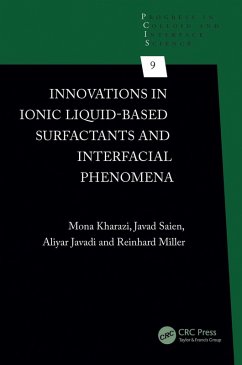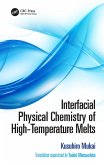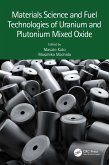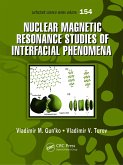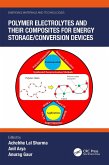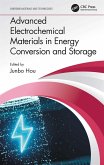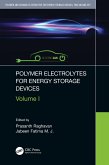Innovations in Ionic Liquid-Based Surfactants and Interfacial Phenomena (eBook, PDF)


Alle Infos zum eBook verschenken

Innovations in Ionic Liquid-Based Surfactants and Interfacial Phenomena (eBook, PDF)
- Format: PDF
- Merkliste
- Auf die Merkliste
- Bewerten Bewerten
- Teilen
- Produkt teilen
- Produkterinnerung
- Produkterinnerung

Hier können Sie sich einloggen

Bitte loggen Sie sich zunächst in Ihr Kundenkonto ein oder registrieren Sie sich bei bücher.de, um das eBook-Abo tolino select nutzen zu können.
Innovations in Ionic Liquid-Based Surfactants and Interfacial Phenomena" offers a comprehensive exploration of ionic liquid-based surfactants (ILBSs) and their transformative potential. This book is divided into three sections. Section I establishes the fundamental properties of ionic liquids (ILs) and ILBSs, emphasizing their unique structures, environmental advantages, and flexible design. It details the diverse types of ILBSs, highlighting their individual characteristics and applications. Section II delves into the crucial interfacial behavior of ILBSs, examining their role in reducing…mehr
- Geräte: PC
- mit Kopierschutz
- eBook Hilfe
- Größe: 22.76MB
![Innovations in Ionic Liquid-Based Surfactants and Interfacial Phenomena (eBook, ePUB) Innovations in Ionic Liquid-Based Surfactants and Interfacial Phenomena (eBook, ePUB)]() Mona KharaziInnovations in Ionic Liquid-Based Surfactants and Interfacial Phenomena (eBook, ePUB)185,95 €
Mona KharaziInnovations in Ionic Liquid-Based Surfactants and Interfacial Phenomena (eBook, ePUB)185,95 €![Interfacial Physical Chemistry of High-Temperature Melts (eBook, PDF) Interfacial Physical Chemistry of High-Temperature Melts (eBook, PDF)]() Kusuhiro MukaiInterfacial Physical Chemistry of High-Temperature Melts (eBook, PDF)48,95 €
Kusuhiro MukaiInterfacial Physical Chemistry of High-Temperature Melts (eBook, PDF)48,95 €![Materials Science and Fuel Technologies of Uranium and Plutonium Mixed Oxide (eBook, PDF) Materials Science and Fuel Technologies of Uranium and Plutonium Mixed Oxide (eBook, PDF)]() Materials Science and Fuel Technologies of Uranium and Plutonium Mixed Oxide (eBook, PDF)43,95 €
Materials Science and Fuel Technologies of Uranium and Plutonium Mixed Oxide (eBook, PDF)43,95 €![Nuclear Magnetic Resonance Studies of Interfacial Phenomena (eBook, PDF) Nuclear Magnetic Resonance Studies of Interfacial Phenomena (eBook, PDF)]() Vladimir M. Gun'koNuclear Magnetic Resonance Studies of Interfacial Phenomena (eBook, PDF)188,95 €
Vladimir M. Gun'koNuclear Magnetic Resonance Studies of Interfacial Phenomena (eBook, PDF)188,95 €![Polymer Electrolytes and their Composites for Energy Storage/Conversion Devices (eBook, PDF) Polymer Electrolytes and their Composites for Energy Storage/Conversion Devices (eBook, PDF)]() Polymer Electrolytes and their Composites for Energy Storage/Conversion Devices (eBook, PDF)54,95 €
Polymer Electrolytes and their Composites for Energy Storage/Conversion Devices (eBook, PDF)54,95 €![Advanced Electrochemical Materials in Energy Conversion and Storage (eBook, PDF) Advanced Electrochemical Materials in Energy Conversion and Storage (eBook, PDF)]() Advanced Electrochemical Materials in Energy Conversion and Storage (eBook, PDF)51,95 €
Advanced Electrochemical Materials in Energy Conversion and Storage (eBook, PDF)51,95 €![Polymer Electrolytes for Energy Storage Devices (eBook, PDF) Polymer Electrolytes for Energy Storage Devices (eBook, PDF)]() Polymer Electrolytes for Energy Storage Devices (eBook, PDF)48,95 €
Polymer Electrolytes for Energy Storage Devices (eBook, PDF)48,95 €-
-
-
Dieser Download kann aus rechtlichen Gründen nur mit Rechnungsadresse in A, B, BG, CY, CZ, D, DK, EW, E, FIN, F, GR, HR, H, IRL, I, LT, L, LR, M, NL, PL, P, R, S, SLO, SK ausgeliefert werden.
- Produktdetails
- Verlag: Taylor & Francis eBooks
- Seitenzahl: 328
- Erscheinungstermin: 22. Juli 2025
- Englisch
- ISBN-13: 9781040382691
- Artikelnr.: 74331384
- Verlag: Taylor & Francis eBooks
- Seitenzahl: 328
- Erscheinungstermin: 22. Juli 2025
- Englisch
- ISBN-13: 9781040382691
- Artikelnr.: 74331384
- Herstellerkennzeichnung Die Herstellerinformationen sind derzeit nicht verfügbar.
Websites: https://scholar.google.com/citations?user=jIkez6UAAAAJ&hl=en
https://www.researchgate.net/profile/Mona-Kharazi
ORCID: 0000-0001-6645-0176
Javad Saien is a faculty member in the Faculty of Chemistry and Petroleum Sciences at Bu-Ali Sina University, Hamedan, Iran. He received his B.Sc. from Amirkabir University of Technology (1984), his M.Sc. from the University of Tehran (1991), and his Ph.D. in Chemical Engineering from the University of Bradford, UK (1995). Since 1986, he has been serving as an academic staff member at Bu-Ali Sina University, where he was promoted to full professor approximately 15 years ago. His research primarily focused on enhanced oil recovery using ionic liquids and nanoparticles, wastewater treatment via homogeneous and heterogeneous processes, liquid-liquid extraction (including single drop, impinging streams, and LLE), and mass transfer intensification using external fields. He has published over 200 journal articles, holds numerous national and international patents, and has authored several books and book chapters. Since 2020, he has been serving as the editor of the Journal of the Iranian Chemical Society, and he is a member of the editorial boards of various national and international scientific journals.
Website: https://profs.basu.ac.ir/saeen/
https://scholar.google.com/citations?user=V0yXsg8AAAAJ&hl=en
https://www.researchgate.net/profile/Javad-Saien
ORCID: 0000-0001-5731-022
Aliyar Javadi is a pioneer scientist in dynamic surface phenomena, interfacial transport properties of multiphase processes, and biointerfaces. He earned his B.Sc. (1996) in chemical engineering from Amirkabir University of Technology (Tehran Polytechnique), and his M.Sc. (2000) and Ph.D. (2007) from Sharif University of Technology, Tehran, Iran. He continued his research work at the Max Planck Institute for Colloids and Interfaces in Potsdam, Germany, as a postdoc and project leader.
Since 2013, he has been serving as a professor in the Department of Chemical Engineering at the University of Tehran, where he developed a working group and laboratory on "Dynamic surface phenomena and colloidal systems". He is currently in collaboration with TU-Dresden and the Helmholtz Centre in Dresden-Rossendorf, Germany, for developing new projects on dynamic surface phenomena and biointerfaces. He is the scientific director of the World-Academies newly founded as knowledge management startup at the TU-Dresden for Remote Training and Research. He has published his scientific achievements in more than 120 international journal articles and book chapters, mostly on the dynamic interfacial properties of multiphase processes.
Websites: https://www.world-academies.com/members/javadi/; https://tu-dresden.de/ing/maschinenwesen/ifvu/tpg/die-professur/beschaeftigte/Aliyar_Javadi; https://scholar.google.de/citations?user=DhbZvksAAAAJ&hl=de
ORCID: 0000-0002-9881-7304
Reinhard Miller is an associated senior scientist in the Institute for Condensed Matter Physics, Technical University of Darmstadt, Germany. He studied mathematics at the University of Rostock and colloid science at the Technical University of Dresden, Germany. He earned his Ph.D. and habilitation from the Academy of Sciences in Berlin. In 1990, he was a postdoc at the University of Toronto, Canada. From 1991 to 2019, he was a group leader at the Max Planck Institute of Colloids and Interface in Potsdam. Since then, he continued his scientific work as an associated senior scientist at the Technical University of Darmstadt.
His main scientific interests are dynamics and thermodynamics of adsorption of surfactants, proteins, polymers, particles and their mixtures at fluid interfaces, dilational and shear interfacial rheology, and formation and stabilization of foams and emulsions. He has published his scientific results in eight books, more than 650 papers in peer-reviewed journals, and many book chapters. He is the editor of the journal Advances in Colloid and Interface Science and the editor-in-chief of the journal Colloids & Interfaces. He is also the editor of the book series Progress in Colloid and Interface Science (CRC Press).
Websites: https://www.ipkm.tu-darmstadt.de/research_ipkm/team_ipkm/team_ipkm_details_74624.de.jsp; https://scholar.google.de/citations?user=FEoPQ3UAAAAJ&hl=de
ORCID: 0000-0001-8943-7521
Section I: Ionic Liquids Structure
Chapter 1: Characteristic Features
1.1. Introduction
1.2. General Features
1.2.1. Ionic liquids
1.2.2. Molten salts
1.3. Ionic Liquids Properties
1.3.1. Melting point
1.3.2. Vapor pressure
1.3.3. Thermal stability and non-flammability
1.3.4. Structural designability
1.3.5. Electrical conductivity
1.3.6. Viscosity
1.3.7. Liquid state over a wide temperature range
1.3.8. Magnetic property
1.3.9. Solvation potential
1.4. Summary
1.5. References
Chapter 2: Ionic Liquid-Based Surfactants
2.1. Introduction
2.2. Structure and Characteristics of Ionic Liquid-Based Surfactants
2.2.1. General consideration
2.2.2. Head group effects
2.2.3. Alkyl chain effects
2.2.4. Counter anion effects
2.2.5. Hydrophilic-lipophilic balance
2.3. Classification of Ionic Liquid-Based Surfactants
2.3.1. Single-chain ILBSs
2.3.2. Multicationic ILBSs
2.3.3. Zwitterionic ILBSs
2.3.4. Catanionic ILBSs
2.3.5. Novel ILBSs
2.4. Ionic Liquid-Based Surfactants and Green Chemistry
2.4.1. Toxicity
2.4.2. Biodegradability
2.5. Summary
2.6. References
Section II: Interfacial Phenomena
Chapter 3: Interface Properties AND Interfacial Tension Reduction
3.1. Introduction
3.2. Interfacial Tension Concepts
3.3. Methods of Determining Interfacial Tension
3.4. Role of Surfactant in Interfacial Tension Reduction
3.4.1. Dynamic interfacial tension
3.4.2. Adsorption models for surfactants at liquid interfaces
3.5. Ionic Liquid-Based Surfactants and Interfacial Tension Reduction
3.6. Impact of Ionic Liquid-Based Surfactants Structure on Interfacial
Tension
3.6.1. Head group effects
3.6.2. Alkyl chain effects
3.6.3. Counter anion effects
3.6.4. Spacer effects
3.7. Comparing Effectiveness of Different Types of Ionic Liquid-Based
Surfactants
3.7.1. Single-chain type ILBSs
3.7.2. Multicationic type ILBSs
3.7.3. Zwitterionic type ILBSs
3.7.4. Catanionic type ILBSs
3.8. Summary
3.9. References
Chapter 4: Micelle Formation
4.1. Introduction
4.2. Micelle and Critical Micelle Concentration Concepts
4.3. Micellar Structures
4.3.1. Structures and classification of micelles
4.3.2. Liquid crystals
4.3.3. Factors affecting micellar structures and packing parameter
4.3.4. Micellar aggregation number
4.4. Methods of Determining Critical Micelle Concentration
4.5. Ionic Liquid-Based Surfactants and Critical Micelle Concentration
4.6. Impact of Ionic Liquid-Based Surfactants Structure on Critical Micelle
Concentration
4.6.1. Head group effects
4.6.2. Alkyl chain effects
4.6.3. Counter anion effects
4.6.4. Spacer effects
4.7. Comparing Effectiveness of Different Types of Ionic Liquid-Based
Surfactants
4.7.1. Single-chain type ILBSs
4.7.2. Multicationic type ILBSs
4.7.3. Zwitterionic type ILBSs
4.7.4. Catanionic type ILBSs
4.8. Summary
4.9. References
Chapter 5: Emulsification
5.1. Introduction
5.2. Emulsification Concepts
5.3. Types of Emulsions
5.3.1. Classification based on the dispersed phase
5.3.2. Classification based on the size of the dispersed droplets
5.3.3. Classification based on the nature of emulsifier
5.3.4. Classification based on the Winsor types
5.4. Emulsion Stability
5.4.1. The DLVO theory and emulsion index
5.4.2. Destabilizing factors of emulsions
5.4.3. Stabilizing factors of emulsions
5.5. Ionic Liquid-Based Surfactants and Emulsification
5.6. Impact of Ionic Liquid-Based Surfactants Structure on Emulsification
5.6.1. Head group effects
5.6.2. Alkyl chain effects
5.6.3. Counter anion effects
5.7. Comparing Effectiveness of Different Types of Ionic Liquid-Based
Surfactants
5.7.1. Single-chain type ILBSs
5.7.2. Multicationic type ILBSs
5.7.3. Zwitterionic type ILBSs
5.7.4. Catanionic type ILBSs
5.8. The Hydrophilic-Lipophilic Balance of Ionic Liquid-Based Surfactants
5.9. Summary
5.10. References
Chapter 6: Wettability Modifications
6.1. Introduction
6.2. Wetting and Wettability Concepts
6.2.1. Wetting and types
6.2.2. Wettability and its modification
6.3. Methods of Determining the Wettability
6.3.1. Surface and interfacial tension measurements
6.3.2. Contact angle measurements
6.3.3. Adsorption and spreading measurements
6.3.4. Wetting balance measurements
6.3.5. Imbibition measurements
6.4. Role of Surfactant in Wetting Modifications
6.4.1. Mechanism of surfactants adsorption at the solid surface
6.4.2. Wettability changes with surfactants
6.5. Ionic Liquid-Based Surfactants and Wettability Modification
6.6. Impact of Ionic Liquid-Based Surfactants Structure on Wettability
Modification
6.6.1. Head group effects
6.6.2. Alkyl chain effects
6.6.3. Counter anion effects
6.7. Comparing Effectiveness of Different Types of Ionic Liquid-Based
Surfactants
6.7.1. Single-chain type ILBSs
6.7.2. Multicationic type ILBSs
6.7.3. Zwitterionic type ILBSs
6.7.4. Catanionic type ILBSs
6.8. Summary
6.9. References
Section III: Applications
Chapter 7: Particle Dispersions
7.1. Introduction
7.2. Particle Dispersion Concepts
7.3. Mechanisms of Stabilizing Dispersions
7.3.1. Electrostatic stabilization
7.3.2. Steric stabilization
7.3.3. Electrosteric stabilization
7.4. Role of Surfactants in Dispersion of Particles
7.4.1. Wetting of powder
7.4.2. De-aggregating of particle clusters
7.4.3. Preventing re-aggregation of dispersed particles
7.5. Ionic Liquid-Based Surfactants and Particle Dispersion
7.6. Impact of Ionic Liquid-Based Surfactants Structure on Particle
Dispersion
7.6.1. Head group effects
7.6.2. Alkyl chain effects
7.6.3. Counter anion effects
7.7. Comparing Effectiveness of Different Types of Ionic Liquid-Based
Surfactants
7.7.1. Single-chain type ILBSs
7.7.2. Multicationic type ILBSs
7.7.3. Zwitterionic type ILBSs
7.7.4. Catanionic type ILBSs
7.8. Summary
7.9. References
Chapter 8: Extraction Processes
8.1. Introduction
8.2. Extraction Process Concepts
8.3. Mechanisms of Extraction Processes
8.3.1. Liquid-liquid extraction
8.3.2. Solid-liquid extraction
8.3.3. Solid-phase extraction and dispersive solid-phase extraction
8.4. Role of Surfactant in Extraction Processes
8.4.1. Impact on the liquid-liquid extraction
8.4.2. Impact on the solid-liquid extraction
8.4.3. Impact on the solid-phase extraction and dispersive solid-phase
extraction
8.4.4. Impact on separation of extracted substance from the solvent
8.5. Ionic Liquid-Based Surfactants and Extraction Processes
8.6. Impact of Ionic Liquid-Based Surfactants Structure on Extraction
Processes
8.6.1. Head group effects
8.6.2. Alkyl chain effects
8.6.3. Counter anion effects
8.7. Comparing Effectiveness of Different Types of Ionic Liquid-Based
Surfactants
8.7.1. Single-chain type ILBSs
8.7.2. Multicationic type ILBSs
8.7.3. Zwitterionic type ILBSs
8.7.4. Catanionic type ILBSs
8.8. Summary
8.9. References
Chapter 9: Enhanced Oil Recovery
9.1. Introduction
9.2. Enhanced Oil Recovery Concepts
9.2.1. Primary crude oil recovery
9.2.2. Secondary crude oil recovery
9.2.3. Tertiary crude oil recovery
9.3. Role of Surfactant in Enhanced Oil Recovery
9.4. Ionic Liquid-Based Surfactants and Enhanced Oil Recovery
9.5. Enhanced Oil Recovery with Surfactant Flooding
9.5.1. Mechanism of surfactant flooding
9.5.2. Impact of ILBSs structure on surfactants flooding
9.5.3. Comparing effectiveness of different types of ILBSs
9.6. Enhanced Oil Recovery with Micellar Flooding
9.6.1. Mechanism of micellar flooding
9.6.2. Impact of ILBSs structure on micellar flooding
9.6.3. Comparing effectiveness of different types of ILBSs
9.7. Enhanced Oil Recovery with Wettability Alteration
9.7.1. Mechanism of wettability Alteration
9.7.2. Impact of ILBSs structure on wettability alteration
9.7.3. Comparing effectiveness of different types of ILBSs
9.8. Summary
9.9. References
Index I: Abbreviations
Index II: Name of ILBSs and Surfactants
Index III: Subject Index
Section I: Ionic Liquids Structure
Chapter 1: Characteristic Features
1.1. Introduction
1.2. General Features
1.2.1. Ionic liquids
1.2.2. Molten salts
1.3. Ionic Liquids Properties
1.3.1. Melting point
1.3.2. Vapor pressure
1.3.3. Thermal stability and non-flammability
1.3.4. Structural designability
1.3.5. Electrical conductivity
1.3.6. Viscosity
1.3.7. Liquid state over a wide temperature range
1.3.8. Magnetic property
1.3.9. Solvation potential
1.4. Summary
1.5. References
Chapter 2: Ionic Liquid-Based Surfactants
2.1. Introduction
2.2. Structure and Characteristics of Ionic Liquid-Based Surfactants
2.2.1. General consideration
2.2.2. Head group effects
2.2.3. Alkyl chain effects
2.2.4. Counter anion effects
2.2.5. Hydrophilic-lipophilic balance
2.3. Classification of Ionic Liquid-Based Surfactants
2.3.1. Single-chain ILBSs
2.3.2. Multicationic ILBSs
2.3.3. Zwitterionic ILBSs
2.3.4. Catanionic ILBSs
2.3.5. Novel ILBSs
2.4. Ionic Liquid-Based Surfactants and Green Chemistry
2.4.1. Toxicity
2.4.2. Biodegradability
2.5. Summary
2.6. References
Section II: Interfacial Phenomena
Chapter 3: Interface Properties AND Interfacial Tension Reduction
3.1. Introduction
3.2. Interfacial Tension Concepts
3.3. Methods of Determining Interfacial Tension
3.4. Role of Surfactant in Interfacial Tension Reduction
3.4.1. Dynamic interfacial tension
3.4.2. Adsorption models for surfactants at liquid interfaces
3.5. Ionic Liquid-Based Surfactants and Interfacial Tension Reduction
3.6. Impact of Ionic Liquid-Based Surfactants Structure on Interfacial
Tension
3.6.1. Head group effects
3.6.2. Alkyl chain effects
3.6.3. Counter anion effects
3.6.4. Spacer effects
3.7. Comparing Effectiveness of Different Types of Ionic Liquid-Based
Surfactants
3.7.1. Single-chain type ILBSs
3.7.2. Multicationic type ILBSs
3.7.3. Zwitterionic type ILBSs
3.7.4. Catanionic type ILBSs
3.8. Summary
3.9. References
Chapter 4: Micelle Formation
4.1. Introduction
4.2. Micelle and Critical Micelle Concentration Concepts
4.3. Micellar Structures
4.3.1. Structures and classification of micelles
4.3.2. Liquid crystals
4.3.3. Factors affecting micellar structures and packing parameter
4.3.4. Micellar aggregation number
4.4. Methods of Determining Critical Micelle Concentration
4.5. Ionic Liquid-Based Surfactants and Critical Micelle Concentration
4.6. Impact of Ionic Liquid-Based Surfactants Structure on Critical Micelle
Concentration
4.6.1. Head group effects
4.6.2. Alkyl chain effects
4.6.3. Counter anion effects
4.6.4. Spacer effects
4.7. Comparing Effectiveness of Different Types of Ionic Liquid-Based
Surfactants
4.7.1. Single-chain type ILBSs
4.7.2. Multicationic type ILBSs
4.7.3. Zwitterionic type ILBSs
4.7.4. Catanionic type ILBSs
4.8. Summary
4.9. References
Chapter 5: Emulsification
5.1. Introduction
5.2. Emulsification Concepts
5.3. Types of Emulsions
5.3.1. Classification based on the dispersed phase
5.3.2. Classification based on the size of the dispersed droplets
5.3.3. Classification based on the nature of emulsifier
5.3.4. Classification based on the Winsor types
5.4. Emulsion Stability
5.4.1. The DLVO theory and emulsion index
5.4.2. Destabilizing factors of emulsions
5.4.3. Stabilizing factors of emulsions
5.5. Ionic Liquid-Based Surfactants and Emulsification
5.6. Impact of Ionic Liquid-Based Surfactants Structure on Emulsification
5.6.1. Head group effects
5.6.2. Alkyl chain effects
5.6.3. Counter anion effects
5.7. Comparing Effectiveness of Different Types of Ionic Liquid-Based
Surfactants
5.7.1. Single-chain type ILBSs
5.7.2. Multicationic type ILBSs
5.7.3. Zwitterionic type ILBSs
5.7.4. Catanionic type ILBSs
5.8. The Hydrophilic-Lipophilic Balance of Ionic Liquid-Based Surfactants
5.9. Summary
5.10. References
Chapter 6: Wettability Modifications
6.1. Introduction
6.2. Wetting and Wettability Concepts
6.2.1. Wetting and types
6.2.2. Wettability and its modification
6.3. Methods of Determining the Wettability
6.3.1. Surface and interfacial tension measurements
6.3.2. Contact angle measurements
6.3.3. Adsorption and spreading measurements
6.3.4. Wetting balance measurements
6.3.5. Imbibition measurements
6.4. Role of Surfactant in Wetting Modifications
6.4.1. Mechanism of surfactants adsorption at the solid surface
6.4.2. Wettability changes with surfactants
6.5. Ionic Liquid-Based Surfactants and Wettability Modification
6.6. Impact of Ionic Liquid-Based Surfactants Structure on Wettability
Modification
6.6.1. Head group effects
6.6.2. Alkyl chain effects
6.6.3. Counter anion effects
6.7. Comparing Effectiveness of Different Types of Ionic Liquid-Based
Surfactants
6.7.1. Single-chain type ILBSs
6.7.2. Multicationic type ILBSs
6.7.3. Zwitterionic type ILBSs
6.7.4. Catanionic type ILBSs
6.8. Summary
6.9. References
Section III: Applications
Chapter 7: Particle Dispersions
7.1. Introduction
7.2. Particle Dispersion Concepts
7.3. Mechanisms of Stabilizing Dispersions
7.3.1. Electrostatic stabilization
7.3.2. Steric stabilization
7.3.3. Electrosteric stabilization
7.4. Role of Surfactants in Dispersion of Particles
7.4.1. Wetting of powder
7.4.2. De-aggregating of particle clusters
7.4.3. Preventing re-aggregation of dispersed particles
7.5. Ionic Liquid-Based Surfactants and Particle Dispersion
7.6. Impact of Ionic Liquid-Based Surfactants Structure on Particle
Dispersion
7.6.1. Head group effects
7.6.2. Alkyl chain effects
7.6.3. Counter anion effects
7.7. Comparing Effectiveness of Different Types of Ionic Liquid-Based
Surfactants
7.7.1. Single-chain type ILBSs
7.7.2. Multicationic type ILBSs
7.7.3. Zwitterionic type ILBSs
7.7.4. Catanionic type ILBSs
7.8. Summary
7.9. References
Chapter 8: Extraction Processes
8.1. Introduction
8.2. Extraction Process Concepts
8.3. Mechanisms of Extraction Processes
8.3.1. Liquid-liquid extraction
8.3.2. Solid-liquid extraction
8.3.3. Solid-phase extraction and dispersive solid-phase extraction
8.4. Role of Surfactant in Extraction Processes
8.4.1. Impact on the liquid-liquid extraction
8.4.2. Impact on the solid-liquid extraction
8.4.3. Impact on the solid-phase extraction and dispersive solid-phase
extraction
8.4.4. Impact on separation of extracted substance from the solvent
8.5. Ionic Liquid-Based Surfactants and Extraction Processes
8.6. Impact of Ionic Liquid-Based Surfactants Structure on Extraction
Processes
8.6.1. Head group effects
8.6.2. Alkyl chain effects
8.6.3. Counter anion effects
8.7. Comparing Effectiveness of Different Types of Ionic Liquid-Based
Surfactants
8.7.1. Single-chain type ILBSs
8.7.2. Multicationic type ILBSs
8.7.3. Zwitterionic type ILBSs
8.7.4. Catanionic type ILBSs
8.8. Summary
8.9. References
Chapter 9: Enhanced Oil Recovery
9.1. Introduction
9.2. Enhanced Oil Recovery Concepts
9.2.1. Primary crude oil recovery
9.2.2. Secondary crude oil recovery
9.2.3. Tertiary crude oil recovery
9.3. Role of Surfactant in Enhanced Oil Recovery
9.4. Ionic Liquid-Based Surfactants and Enhanced Oil Recovery
9.5. Enhanced Oil Recovery with Surfactant Flooding
9.5.1. Mechanism of surfactant flooding
9.5.2. Impact of ILBSs structure on surfactants flooding
9.5.3. Comparing effectiveness of different types of ILBSs
9.6. Enhanced Oil Recovery with Micellar Flooding
9.6.1. Mechanism of micellar flooding
9.6.2. Impact of ILBSs structure on micellar flooding
9.6.3. Comparing effectiveness of different types of ILBSs
9.7. Enhanced Oil Recovery with Wettability Alteration
9.7.1. Mechanism of wettability Alteration
9.7.2. Impact of ILBSs structure on wettability alteration
9.7.3. Comparing effectiveness of different types of ILBSs
9.8. Summary
9.9. References
Index I: Abbreviations
Index II: Name of ILBSs and Surfactants
Index III: Subject Index
